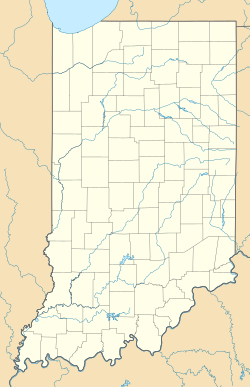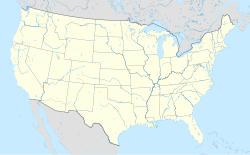Athenæum (Das Deutsche Haus)
Athenæum (Das Deutsche Haus) | |
 The Athenæum in 2011. | |
| Location | 401 E. Michigan St., Indianapolis, Indiana |
|---|---|
| Coordinates | 39°46′24″N 86°9′1″W / 39.77333°N 86.15028°W |
| Area | 1 acre (0.40 ha) |
| Built | 1893 |
| Architect | Vonnegut & Bohn; Multiple |
| Architectural style | Renaissance Revival |
| NRHP reference No. | 73000032[1] |
| Significant dates | |
| Added to NRHP | February 21, 1973 |
| Designated NHL | October 31, 2016[2] |
The Athenæum, originally named Das Deutsche Haus (German: "The German House"), is the most ornate and best-preserved building affiliated with the German American community of Indianapolis. Once used as a German American Turnverein and clubhouse, it currently houses many groups, organizations, and businesses. The Athenæum is located across Massachusetts Avenue from the Old National Centre. It was placed on the National Register of Historic Places on February 21, 1973. On October 31, 2016, it was named the 41st National Historic Landmark in Indiana.[2]
History
[edit]
In the 19th century, many German immigrants made their home in Indiana. A majority of these immigrants, called Forty-Eighters, relocated to the United States following the failed Revolutions of 1848 in the German states. These immigrants quickly formed musical, political, and social clubs after the German idea of club life, including the Männerchor, Turnverein, and Liederkranz. Many of these immigrants believed in the philosophy of Friedrich Ludwig Jahn. In 1892, to preserve their German heritage, the German clubs formed the Sozialer Turnverein Aktiengesellschaft (German: Social Gymnastics Association Inc.), an association to finance the building of a clubhouse. The clubhouse was built as a house of culture for the mind and body. All the German clubs would be united under a single roof.[3]
For a cost of $32,000, two lots were purchased at the corner of Michigan and New Jersey streets. A German neighborhood called Lockerbie Square, also known as Germantown, surrounded the clubhouse. Construction of the East Wing began in May 1893, and was finished in 1894. The West Wing construction started in 1897 and was completed in 1898.[3] German American architects Bernard Vonnegut Sr. (grandfather of Indianapolis novelist Kurt Vonnegut) and Arthur Bohn designed both wings.[4] It was called Das Deutsche Haus and hosted many organizations, including the German-American Veterans Society, the German-American School Society, the Socialer Turnverein Women's Club, the German Ladies' Aid Society, and the Turner Building and Savings Association.[5] There were 500 members by 1896.[5][6]
In 1897, the Musikverein (Music Society) was founded at Das Deutsche Haus; it included a 60-piece orchestra, a male choir, and a mixed choir. The Athenaeum Orchestra is now the oldest orchestra in Indianapolis.[5]
In 1907, Das Deutsche Haus agreed to house the Normal College of the American Gymnastic Union in its east wing. The normal school trained physical education teachers for schools across the country. Indiana University incorporated the school in 1941 as a department of the School of Health, Physical Education, and Recreation.[7] It claims to be the oldest school of physical education in the United States.[5]
With the anti-German sentiments of World War I, the clubhouse renamed itself the Athenæum. Today, the Athenaeum is operated by the nonprofit Athenaeum Foundation.
Architecture
[edit]
The front part of the building is the East Wing. It is built in the German Renaissance Revival. The wing has a gable roof. There is a three storied brick tower with a conical slate roof. The entrance is flanked by two Roman Doric columns, and is arched with a semicircle of limestone. The upper windows are arched and the gymnasium has bullseye-shaped windows.
The West Wing is done in the German Renaissance Revival style and incorporates German architecture with Renaissance elements. It has a steep pitched hip roof. This wing also has a three storied brick tower but it has a curved mansard roof and spire. The wing has various window styles and some windows have stained glass. Roman Doric columns are placed beside the arched entrance. At each end of the main roof there are copper covered cupolas. The wing has a baroque pediment above its cornice. The faces of the stone voussoirs of the arches are projected outward. The facade is decorated with terra cotta grotesques. One figure in particular is Athena, the building's namesake, who is placed in the top arch.[8]
Facilities
[edit]
The Athenæum Foundation nonprofit organization is dedicated to preserving the historical Athenæum and serving the Indianapolis community. The foundation sponsors events and programs throughout the year. Free tours of the Athenæum are offered twice a month between March and December. Group tours can also be scheduled.
In the Athenaeum is the Rathskeller Restaurant, which is the oldest restaurant in the city.[5]
|
Events
[edit]In October 2009, the Athenaeum held its first annual GermanFest. The event, held outside on New Jersey Street, featured the Männerchor, the Saenger Chor, Meisterwinds, dachshund races, dancing, children's activities, and a visit from Mayor Greg Ballard.[9]
References
[edit]- ^ "National Register Information System". National Register of Historic Places. National Park Service. March 13, 2009.
- ^ a b "Athenaeum named National Historic Landmark". Indianapolis Star. Gannett. November 2, 2016.
- ^ a b "History of the Athenæum". Athenæum Foundation. Archived from the original on May 14, 2008. Retrieved September 1, 2008.
- ^ "Das Deutsche Haus (The Athenaeum)". Indianapolis. National Park Service. Retrieved September 1, 2008.
- ^ a b c d e "The Athenaeum: A German Legacy". Athenaeum information sheet. Athenaeum.
- ^ "Indiana State Historic Architectural and Archaeological Research Database (SHAARD)" (Searchable database). Department of Natural Resources, Division of Historic Preservation and Archaeology. Retrieved August 1, 2016. Note: This includes David R. Hermanson (August 1970). "National Register of Historic Places Inventory Nomination Form: Athenæum (Das Deutsche Haus)" (PDF). Retrieved August 1, 2016. and Accompanying photographs
- ^ Bulletin of the Normal College of the American Gymnastic Union (PDF). Indiana University. 1958. p. 5. Retrieved August 21, 2020.
- ^ "Architectural Elements". The Athenæum Foundation. Archived from the original on May 14, 2008. Retrieved September 15, 2008.
- ^ "The Original and Fabulous Germanfest!". Athenaeum Foundation. Archived from the original on October 31, 2010. Retrieved October 11, 2009.
External links
[edit]- Historic American Buildings Survey (HABS) No. IN-63, "Das Deutsche Haus, 401 East Michigan Street, Indianapolis, Marion County, IN", 21 photos, 13 data pages
- Athenæum Foundation website
- The Rathskeller Restaurant
- Historic American Buildings Survey in Indiana
- Buildings and structures completed in 1898
- 1898 establishments in Indiana
- Buildings and structures in Indianapolis
- German-American culture in Indiana
- National Register of Historic Places in Indianapolis
- Renaissance Revival architecture in Indiana
- Tourist attractions in Indianapolis
- Clubhouses on the National Register of Historic Places in Indiana
- National Historic Landmarks in Indianapolis
- Turner halls



